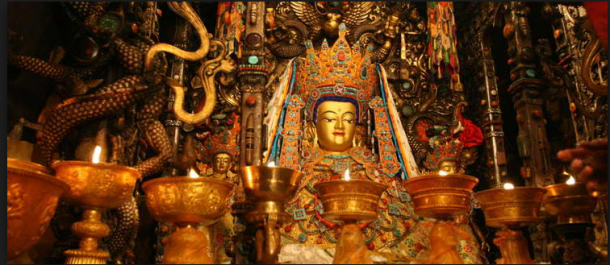The World Of Tibetan Buddhism.

Tibetan Buddhism, the teaching of the Buddha as practiced and taught in Tibet, is at last becoming known to the world. Because of Tibet’s secluded location, the Buddhist tradition developed there for fourteen centuries in relative isolation, unknown or misunderstood by the outside world. Buddism entered Tibet from India in two principal phases ( about 90 % of the “Deminic” deities one sees are actually Indian in origin). The frist phase was during the period of the Yarlung Empire, the Indian figure most associated with this period being, Padmasambhava. The second phase was during the 11Th century. Atisha and Milarepa are the best- known figures of this time.Although both Tibetan and western Buddhism as a systematic and almost deliberate effort, it is more likely that it was the gradual product of the centuries of cultural and religious influence filtering from India and China into the Tibetan highlands. Only much later was this process simplified and categorized by historians.One of the most distinctive features of Tibetan Buddhism is the way it has integrated what it sees as the three principal trends of Indian Buddhism into a coherent, systematic whole. These three trends are the Hinayana, Mahayana and Vajrayana,or the individual, the universal, and the diamond vehicles to enlightenment,respectively.
The Hinayana tradition presents the basic teachings of the histirical Buddha Shakyamuni; these teachings correspond to the tradition that today is preserved by the Theravada Buddhists of Sri Lanka and southeast Asia. The Mahayana tradition introduces a further evolution of ethical and philosophical understanding that started to emerge in India about five hundred years after Shakyamuni. And the Vajrayana, the esoteric or secret form of the Mahayana,is seen as a powerful, direct path thst utilizes symbolic imagination,mantric sound and subtle physical energy to effect a complete psycho-physical transformation from an ordinary person to an enlightened being.
The Importance of the Lama
Tibetan Buddhist tradition places great emphasis on the importance of the lama (the Tibetan equivalent of the Sanskrit term guru). These venerable teachers are often given the honorific title of Rinpoche (“Precious One”). All lamas complete a long course of study that prepares them for their future role as the bestowers of initiations and esoteric teachings. Qualified lamas introduce students to particular teachings and through “empowerments” bestow spiritual energy so that specific practices can be successfully undertaken by students. Formal and informal face-to-face oral transmissions of spiritual insight and wisdom typically occur between lama and student. The lama is the focus of passionate devotion for the aspirant, and is acknowledged to embody the Three Jewels (the Buddha, his teachings, and the sangha) as well as the qualities of the meditational deities. Tibetan Buddhism innovated the idea of “incarnate lamas,” the belief that the mind of a deceased lama can reappear in the new body of a child.
Tibetan Buddhism is adapting by emphasizing a rational scientific approach to its teachings. Buddhism gives a clear explanation of how life’s experiences come about and how to deal with them in the best manner possible. Then it says do not accept anything on blind faith; think for yourself, test it out and see if it actually does make sense. This resembles science asking us to verify the results of an experiment by repeating it ourselves, and only then to accept the results as fact. Modern people do not like buying something without examining it; they would not buy a car without testing it. Likewise, they will not turn to another religion or philosophy of life without checking it first to see if it really makes sense. That is what makes Buddhism so appealing to many people of the twentieth century. Buddhism is open to scientific investigation and invites people to examine it in that way.
Recent Posts
Trekking in Tibet
The Best Way to Experience Mount Kailash in Tibet
The Perfect Tibet Tour Package
All Categories
- About Tibet
- book a Tibet tour
- Buddhism Practice
- Budget Tour
- China-Tibet Train
- Customized Tibet tour
- Historical Sites
- Hot Springs in Tibet
- News
- Photography in Tibet
- Tibet attraction
- Tibet Group Visa
- Tibet Motorcycle Tour
- Tibet Small Group Tours
- Tibet Tours and Tibetan Tour Guide
- Tibet Train
- Tibet Travel FAQs
- Tibet Travel Information
- Tibet Travel News
- Tibet Travel Permit Update
- Tibet Travel Prices Rises
- Tibet Trek
- Tibet Trekking Tour
- Tibet weather and climate
- Tibet Wildlife animals
- Tibet Winter Tour
- Tibetan Buddhism
- Tibetan Cultural Features
- Tibetan Culture and Poeple
- Tibetan Festivals
- What to see in Tibet



